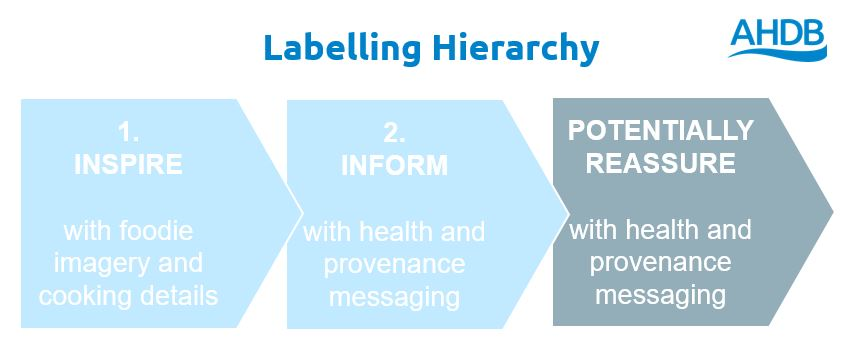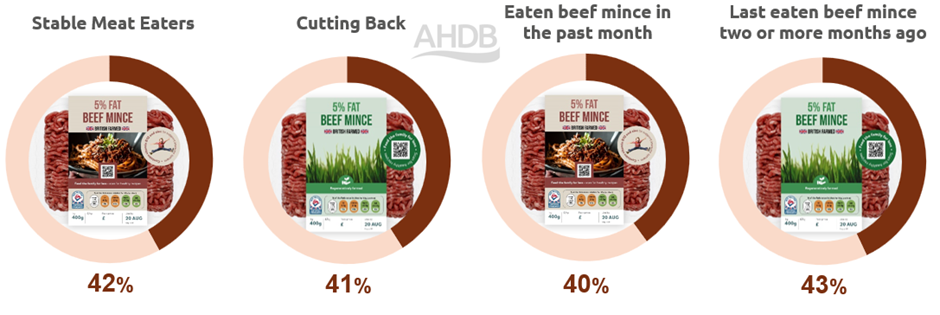- Home
- Hierarchy level 3 – Reassurance on environment and farming
Hierarchy level 3 – Reassurance on environment and farming
Within the hierarchy information, sustainability and animal welfare specifics are seen as a nice to have rather than an essential for many consumers. From the in-store research it was found that these messages work the best and are the most impactful when they are within the fixture and bay rather than on pack.

One of the nuances between subgroups within the research was that shoppers who were cutting back on red meat and shoppers who buy red meat less often were slightly more likely to prefer packs with environmental or sustainability messaging. However, for the most part, they still preferred the packs with the foodie imagery and health messaging.
This difference was most apparent in the mince pack.


Because of the information provided about it being British meat, red tractor, regeneration farming which is positive and makes you feel better about your choice of purchases. Shopper respondent

However, shoppers cutting back on red meat remains a small proportion of the population, with only 20% claiming to be actively cutting back on red meat (Source: AHDB/YouGov Nov 2023). Therefore, unless you are particularly trying to target a meat reducer audience or the product has a particularly unique sustainability message, our recommendation would be for this messaging to be on other point of sale within the aisle.
An additional nuance of both environment and animal welfare messaging is that they often create more questions with consumers than they answer. Therefore, many consumers wanted to know there was a place to go for additional information. This is where we think including QR codes could be useful.
Of the farming and environment messaging, it was the animal grazing ones which came out top.
Which of the below messages would encourage you to make a purchase? (of those interested in farming and sustainability messaging)
|
Comes from grass-fed and free range animals |
73% |
|
Comes from animals that are outdoor bred |
66% |
|
50% less packaging and fully recyclable |
62% |
|
Our farmers high standards maintain top animal health and welfare |
57% |
|
Eating locally sourced meat reduces your food miles |
55% |
|
Our animal welfare standards are world class |
54% |
|
World leading standards in animal health, welfare and food safety |
48% |
|
Red meat from the UK is amongst the most sustainable in the world |
41% |
|
Regeneratively farmed |
35% |
|
The carbon footprint of British pork has fallen by over a third since 2003 |
18% |
Plastic reduction was also included as an option here and it came in third position, showing this is also still important to shoppers but perhaps to a lesser extent than in previous years when plastic was the biggest environmental and farming issue for many consumers. However, it was still the biggest environment message.
If you were going to use secondary imagery on your environmental or animal welfare messaging, the research showed shoppers prefer grass or imagery of fields. Although some shoppers didn’t mind imagery of animals, most were put off by seeing animal imagery on pack.
Environment and farming summary:
- This messaging still works best within the meat bay
- However, if your product has a unique environment or animal welfare message you could include it for stand out which would appeal to those cutting back
- Including this messaging on pack can give consumers more questions, so utilise QR codes for those who want more information


Sign up to receive the latest information from AHDB.
While AHDB seeks to ensure that the information contained on this webpage is accurate at the time of publication, no warranty is given in respect of the information and data provided. You are responsible for how you use the information. To the maximum extent permitted by law, AHDB accepts no liability for loss, damage or injury howsoever caused or suffered (including that caused by negligence) directly or indirectly in relation to the information or data provided in this publication.
All intellectual property rights in the information and data on this webpage belong to or are licensed by AHDB. You are authorised to use such information for your internal business purposes only and you must not provide this information to any other third parties, including further publication of the information, or for commercial gain in any way whatsoever without the prior written permission of AHDB for each third party disclosure, publication or commercial arrangement. For more information, please see our Terms of Use and Privacy Notice or contact the Director of Corporate Affairs at info@ahdb.org.uk © Agriculture and Horticulture Development Board. All rights reserved.

